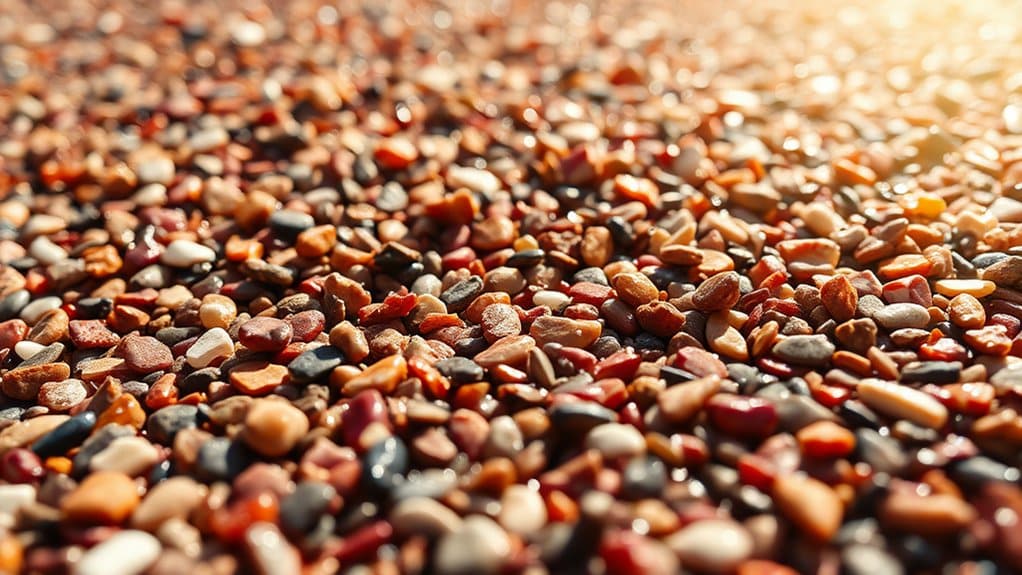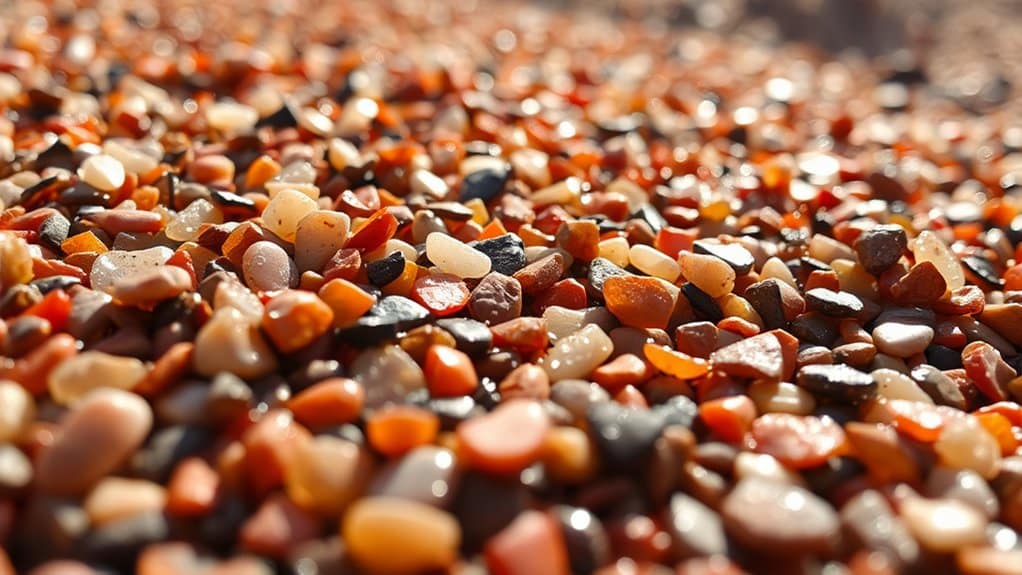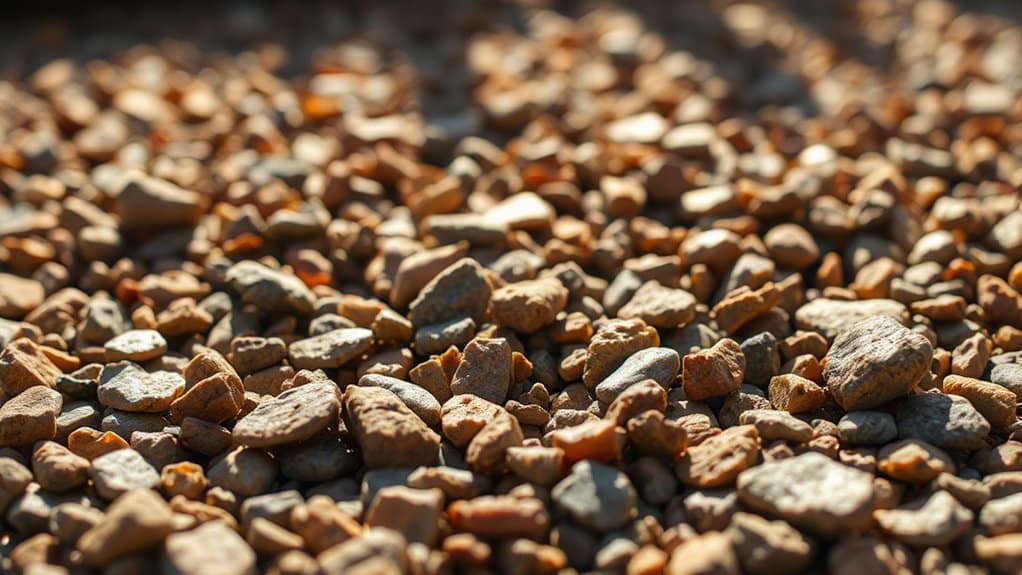The robust nature of polyurethane makes it essential in resin-bound gravel systems across Britain. This tough material creates surfaces that handle both heavy vehicle use and our notorious wet weather brilliantly. Perfect for domestic driveways and garden paths, it allows rainwater to drain naturally, meeting SUDS requirements whilst preventing puddles. The material's strength against UV rays and general wear means your surface stays looking fresh for years. Whether you're revamping your driveway or creating new garden paths, polyurethane-based resin delivers reliable, lasting results.
Key Takeaways
Strong, flexible polyurethane makes resin-bound gravel ideal for British weather and heavy use. Whether it's your garden path or the local shopping centre car park, these surfaces withstand both foot traffic and vehicles without breaking up.
The material's lightweight nature means it works brilliantly across different settings – you'll find it everywhere from residential driveways to public squares. Its porous structure helps tackle our rainy climate, letting water drain through rather than forming puddles, which supports sustainable drainage requirements.
UV-resistant and weather-proof, polyurethane-bound gravel stays looking smart for decades with minimal upkeep – typically lasting 25-30 years. Different types of polyurethane resins are available to suit your specific needs, whether you need quick-drying for a busy commercial project or extra durability for a high-traffic area.
The system's versatility means you can choose from various local aggregates and colours to match your property or surroundings whilst maintaining all the practical benefits.
Importance of Polyurethane in Gravel Mixes

Polyurethane plays a vital role in modern gravel mixes across the UK. Its flexible nature helps gravel surfaces withstand heavy foot traffic and vehicle loads, much like a shock absorber. The material's strong resistance to British weather, particularly frequent rain and UV exposure, keeps surfaces intact throughout the seasons. Despite being lightweight, polyurethane creates remarkably sturdy surfaces suitable for everything from garden paths to car parks. Its ability to maintain drainage is particularly valuable in Britain's wet climate, as it keeps water flowing through the gravel rather than pooling on top. These qualities make polyurethane-enhanced gravel surfaces both practical and environmentally sound, especially in urban areas where proper drainage is crucial. Additionally, this type of surfacing solution is known for its visual appeal and practicality, enhancing aesthetic value while allowing for effective water management. Furthermore, it supports Sustainable Urban Drainage Systems (SuDS), promoting better groundwater replenishment and filtering urban pollutants.
Advantages of Polyurethane Resin-Bound Surfaces

Polyurethane resin-bound surfaces pack plenty of practical benefits.
They're incredibly tough, standing up to British weather and chemicals for up to 30 years with minimal upkeep. Think of them like a tough outdoor carpet that won't fade or crack.
The design options are brilliant – you can choose from loads of colours and textures to match your property, much like picking the perfect paint colour for your house. Additionally, the resin bound surfaces are porous and allow water drainage, preventing any water buildup during heavy rain. This characteristic supports effective water management by reducing surface runoff.
The smooth finish means no awkward lumps or bumps, making it safer for everyone, from kids on bikes to gran's wheelchair.
These surfaces are properly clever with rain, too. Unlike concrete or tarmac, they let water drain through naturally, helping prevent those massive puddles we're all too familiar with in UK weather.
They're a bit pricey upfront, but when you factor in the decades of service and barely any maintenance costs, they're actually quite good value.
For British homeowners looking to boost their property's kerb appeal whilst being practical, resin-bound surfaces are a sound investment that'll last for decades.
Preparation and Application Process

Proper preparation and application are vital for installing resin-bound gravel successfully. Choose your aggregates carefully – you'll need 2-5mm and 1-3mm gravel mixed to specific ratios. Mix the polyurethane resin components in a paddle mixer until they reach a creamy consistency (think double cream texture). Next, mix your dry gravel for 30-60 seconds before adding the resin mixture bit by bit, making sure everything's evenly blended within four minutes. Your base must be clean and stable – imagine prepping a wall before painting. If you're working with concrete, apply a primer for better grip. A solid base achieved using MOT Type 3 hardcore ensures permeability and longevity. Additionally, ensure the existing surface is jet washing 24 hours prior to installation for the best results. Use a trowel to spread and level the mixture, giving it a gentle pat down for an even finish. The ideal temperature for curing is between 12°C and 18°C (typical British spring weather), though actual curing times will vary depending on weather conditions.
Varieties of Polyurethane Resins

Different polyurethane resins play a vital role in resin-bound gravel installations across the UK. The main types include two-liquid systems, moisture-cured and UV-cured variants, each suited to different project needs.
Whilst polyurethane offers excellent strength and durability despite its light weight, it's particularly valued for withstanding British weather conditions and chemical exposure.
For environmentally conscious projects, water-based polyurethane dispersions offer a greener choice with lower VOC emissions – particularly important for residential areas.
The choice between fast and slow-curing options affects working time; fast-curing works well for smaller domestic paths, whilst slow-set suits larger commercial areas like car parks.
Think of the resin choice like picking the right mortar for brickwork – get it right, and you'll have a lasting surface that performs brilliantly.
Get it wrong, and you might face issues down the line. The key is matching the resin type to your specific project requirements and local conditions.
Comparing Polyurethane With Other Binders

Comparing polyurethane with other binders such as epoxy and polyaspartic resins reveals notable differences.
Polyurethane strikes a solid balance between durability and flexibility, making it ideal for flooring in UK warehouses and car parks.
Epoxy, whilst stronger, tends to be more rigid – brilliant for factory floors but less suitable for areas with significant movement.
These differences matter when choosing the right product, much like selecting the proper tyre compound for different driving conditions.
Polyurethane vs. Epoxy Resins
Polyurethane and epoxy resins each offer distinct advantages for bonding materials, and choosing between them can make or break your project.
- Flexibility: Polyurethane bends without breaking, perfect for garage floors or decking where surfaces shift with temperature changes.
- Durability: Epoxy's robust strength suits heavy-duty tasks like workshop benches or industrial flooring.
- UV Stability: Polyurethane maintains its colour in sunlight, whilst epoxy tends to yellow – crucial for garden furniture or outdoor projects.
Both materials are brilliant at what they do, but selecting the right one depends entirely on your specific needs.
If you're tackling a project that needs to flex, go with polyurethane. For something that needs to be rock-solid, epoxy's your best bet.
Polyurethane vs. Polyaspartic Resins
Choosing between polyurethane and polyaspartic resins for your flooring is crucial. Both offer strong chemical resistance, but they serve different purposes.
Polyurethane costs less initially, making sense for larger spaces like warehouses or factories. Polyaspartic coatings, whilst pricier, handle heavy foot traffic and vehicle movement better – think busy car parks or retail floors. They also cure more quickly, letting you get back to business sooner.
Polyurethane stands up well to impacts, but polyaspartic coatings are better at handling heat and scratches. Picture a mechanic's workshop: polyaspartic would better withstand hot tyres and dropped tools.
Your choice should match your needs and budget. If cost is key and you're working on a big area, polyurethane might be your best bet. For high-traffic areas where durability is paramount, polyaspartic could save money long-term despite the higher upfront cost.
Strength and Flexibility Comparison
Polyurethane binders match up differently against epoxy and water-based alternatives, with each having distinct advantages.
- Strength Characteristics: Epoxy resins pack more strength, making them perfect for busy car parks and shopping centres, whilst polyurethane offers good strength with better give for UK temperature swings.
- Flexibility Factors: Unlike stiff epoxy, polyurethane flexes well with Britain's changeable weather, from frosty winters to warm summers.
- Durability: Polyurethane stands up brilliantly to wear and sun damage, lasting far longer than water-based options, which work better for garden paths and light-use areas.
Environmental Benefits of Resin-Bound Gravel Surfaces

Resin-bound gravel surfaces provide excellent drainage benefits, filtering rainwater straight into the ground below.
This natural drainage system meets SUDS requirements whilst reducing flood risks common to British urban areas.
Unlike traditional paving, these surfaces help maintain healthy groundwater levels and prevent waterlogging during heavy rainfall – a particularly useful feature given the UK's wet climate.
Water Permeability Advantages
Water-permeable Resin Surfaces: Key Benefits
Resin-bound gravel offers excellent water drainage, making it ideal for British weather conditions. These surfaces let rainwater soak through naturally, much like a garden lawn, delivering three main advantages:
- Tops up groundwater levels, supporting local water tables
- Helps clean rainwater as it filters through the ground
- Stops soil washing away during heavy rainfall
The tough polyurethane binding keeps everything firmly in place, even after years of use.
It's particularly useful for driveways and paths where puddles and flooding typically cause problems.
This practical solution works with nature rather than against it, requiring minimal upkeep whilst protecting the environment.
Sustainable Urban Drainage Systems
Urban areas across the UK increasingly struggle with rainwater management and flooding. Sustainable Urban Drainage Systems (SuDS) offer a practical solution by working with nature rather than against it. These systems manage rainwater where it falls, cutting flood risks and cleaning water naturally.
Resin-bound gravel is particularly effective for British weather, as it lets water drain through whilst staying sturdy enough for vehicles and foot traffic. Think of SuDS as a series of natural filters – from permeable surfaces to small ponds – that clean pollutants from rainwater before it reaches our rivers and streams.
Beyond flood protection, SuDS create valuable green spaces in our towns and cities. A well-designed system might include rain gardens that support local wildlife or attractive water features that make neighbourhoods more pleasant.
These spaces help improve air quality and give communities practical, sustainable drainage that looks good too. Simply put, SuDS turn a potential problem – excess rainwater – into an asset for UK urban areas, working effectively whilst enhancing local environments.
Frequently Asked Questions
How Long Does Polyurethane Resin Take to Cure Completely?
Polyurethane resin takes between 24 to 72 hours to fully cure. Room temperature conditions around 20°C provide optimal curing times, much like leaving a fresh coat of paint to dry. Warmer environments speed up the process, whilst high humidity slows it down – similar to how a damp day affects paint drying. It's best to allow the full 72 hours in cooler UK weather to ensure a proper finish.
Can Polyurethane Resin Be Applied in Cold Weather?
Yes, polyurethane resin can be applied in cold weather, though proper temperature and moisture control is crucial. Think of it like setting jelly in the fridge – it needs the right conditions to work properly. For best results in chilly British weather, ensure the space is dry and maintain a steady temperature above 10°C. If working outdoors, try to choose a dry day and avoid frosty mornings or damp conditions, as moisture can interfere with the curing process.
What Tools Are Needed for Applying Polyurethane Resin?
Essential tools for polyurethane resin work include forced-action mixers, steel trowels and proper PPE (goggles, gloves and respiratory mask). Quality mixing equipment ensures proper blending, whilst trowels help achieve an even finish. Safety gear is non-negotiable when handling these chemicals.
Is Polyurethane Resin Safe for Pets and Children?
Polyurethane resin requires careful handling to be safe around children and pets, much like household paint or varnish. Keep work areas off-limits whilst applying and curing, ensure proper ventilation (like opening windows and using fans), and wear appropriate safety kit. Once fully cured – typically after 24-48 hours – the resin becomes inert and safe, similar to a plastic cutting board or countertop.
How Do I Repair a Damaged Polyurethane Resin Surface?
"Prevention is better than cure." Repairing a damaged polyurethane resin surface requires proper preparation and precise repair methods to ensure a lasting, smooth finish that holds up to daily wear and tear.
Conclusion
Polyurethane in resin-bound gravel systems delivers enhanced durability whilst maintaining visual appeal. Much like traditional British construction methods that prioritise longevity, using polyurethane creates robust surfaces that withstand UK weather conditions. This modern binding agent produces practical, low-maintenance surfaces ideal for driveways, paths and patios, offering a smart choice for both domestic and commercial projects.
